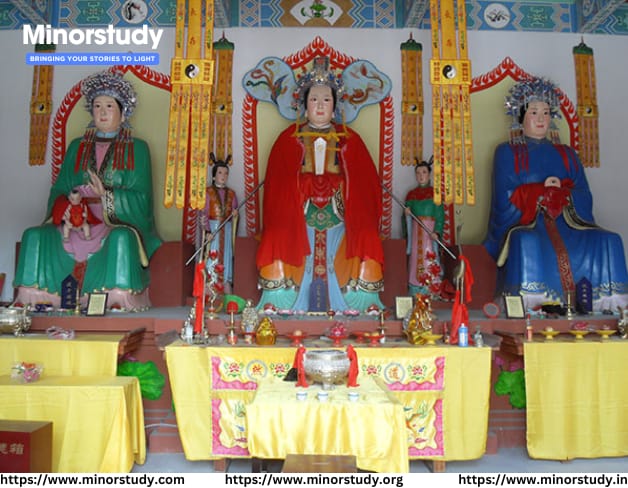🌿 Introduction: The Ancient Soul of Spiritual Humanity
Before temples, churches, mosques, or scriptures—there was Folk Religion. Rooted in oral traditions, rituals, natural elements, and ancestral wisdom, folk religion represents the oldest form of spiritual expression in human history. It is not about doctrines, but about connecting with the forces of nature, spirits, ancestors, and everyday life.
- 📜 History of Folk Religion: From Prehistoric Fires to Village Shrines
- ✨ 9 Fascinating Facts About Folk Religion
- 🕰️ Timeline: Evolution of Folk Religion Through the Ages
- 🌐 Global Examples of Folk Religion
- 📌 Why Folk Religion Still Matters Today
- 🛐 Observance and Rituals in Daily Life
- 🙏 Heartfelt Wishing Example
- ❓ FAQs About Folk Religion
- 📖 What exactly is folk religion?
- 🤔 Is it considered superstition?
- 🙋 Can it coexist with organized religion?
- 🧓 Who performs the rituals?
- 🌍 Is it practiced worldwide?
- 💡 Important Points to Remember
- 🔚 Conclusion: The Gentle Power of Folk Religion in Our Daily Lives
Whether it’s the tribal chants in Africa, the Bhils of India offering to their Kuldevi, or the Día de los Muertos in Mexico, folk religion breathes local identity, healing, and community.
📜 History of Folk Religion: From Prehistoric Fires to Village Shrines
Folk religions existed before the major organized religions emerged. Here’s a brief view of their origins:
Prehistoric Era (before 3000 BCE):
Humans worshiped sun, fire, moon, rain, rivers, and believed in animal spirits and ancestral powers.Ancient Civilizations (3000–1000 BCE):
Egypt, Mesopotamia, and the Indus Valley practiced folk beliefs alongside emerging temple cultures.Axial Age (800–200 BCE):
Organized religions like Hinduism, Buddhism, Zoroastrianism, and early Judaism appeared. Folk traditions coexisted and merged.Middle Ages to Modern Day:
Folk religion continued within Hinduism, Christianity, Islam, etc., often as local customs or syncretic practices.
Even today, over 1 billion people follow or practice elements of folk religion, sometimes without realizing it.
✨ 9 Fascinating Facts About Folk Religion
🌲 Nature is Divine: Trees, rivers, hills, and animals are often considered sacred.
👵 Ancestral Worship: Praying to one’s forefathers is central in Africa, China, India, and Native traditions.
🔮 Spirit Belief: Many cultures believe in spirits—both helpful and harmful—and perform rituals to please them.
🛕 No Scriptures Needed: Unlike organized religions, folk beliefs are passed orally or through symbols.
💀 Death Isn’t the End: Ancestors are seen as part of the living community—offering guidance and protection.
🌀 Syncretism Rules: Many folk traditions blend seamlessly with Buddhism, Hinduism, Christianity, or Islam.
🔥 Fire and Water: Commonly used in purification, prayer, and offerings.
🧿 Amulets & Charms: Used globally to ward off evil or bring good luck.
🫱 Women Play a Central Role: In many communities, it is the women who maintain and transmit folk rituals.
🕰️ Timeline: Evolution of Folk Religion Through the Ages
| Era/Period | Key Developments |
|---|---|
| Prehistoric (Before 3000 BCE) | Animism, nature worship, fire rituals |
| Ancient Civilizations (3000–1000 BCE) | Deity forms emerge, agriculture-based deities develop |
| Classical Period (1000 BCE–500 CE) | Integration with early organized faiths (Hinduism, Zoroastrianism) |
| Medieval Period (500–1500 CE) | Folk saints, shrines, and local gods gain ground |
| Colonial Era (1500–1900 CE) | Suppressed or labeled “superstition” by colonizers |
| Modern Era (1900–present) | Re-evaluation, preservation, and revival in cultural discourse |
🌐 Global Examples of Folk Religion
India: Worship of Gram Devatas (village deities), Nag Panchami, Kuldevis, and rituals like Karni Mata puja.
China: Shenism—ancestor worship, Taoist-folk blend, household shrines.
Africa: Animistic traditions, Yoruba religion, and reverence for ancestral spirits.
Latin America: Santería, Día de los Muertos, and native rituals alongside Christianity.
Europe: Paganism, Wicca, and pre-Christian seasonal festivals.
📌 Why Folk Religion Still Matters Today
Folk religion is not a relic—it’s alive and breathing in villages, urban homes, and even on social media.
🧠 Mental and Emotional Anchoring
When mainstream religions feel distant or institutional, folk practices give personal emotional healing—like tying a thread on a sacred tree or lighting a lamp for ancestors.
🧬 Cultural Identity
Folk rituals preserve local history, customs, dialects, and food traditions.
🫂 Community Cohesion
Folk events like festivals, healing ceremonies, and storytelling nights bring inter-generational bonding and mutual support.
🌍 Environmental Awareness
By worshipping nature as divine, folk religion inherently promotes ecological respect.
🛐 Observance and Rituals in Daily Life
You don’t need a temple to follow folk religion. Some observances include:
🧈 Lighting a Diya (lamp) under the tulsi plant every evening.
🌾 Offering the first harvest to a local deity.
🚩 Worshiping a tree or mountain considered the abode of a spirit.
🐍 Nag Panchami: Feeding milk to serpents as protectors.
💐 Ancestor Shraddha: Annual offering to deceased elders.
🕊️ Exorcism rituals or healing chants by village shamans.
🙏 Heartfelt Wishing Example
“May the wisdom of our ancestors and the kindness of unseen spirits guide your life. May the sacred trees, rivers, and stones protect your journey and bless your family with abundance and peace.”
❓ FAQs About Folk Religion
📖 What exactly is folk religion?
It refers to localized spiritual practices, beliefs, and rituals that are not part of organized religion, but deeply rooted in tradition and daily life.
🤔 Is it considered superstition?
Not necessarily. While often dismissed as superstition, many folk beliefs are based on deep spiritual logic, nature cycles, and cultural meaning.
🙋 Can it coexist with organized religion?
Yes. Many people are both Hindu and followers of their Kuldevi, or both Christian and practitioners of Santería.
🧓 Who performs the rituals?
Often, elders or women of the family. In tribal communities, shamans or healers conduct major ceremonies.
🌍 Is it practiced worldwide?
Absolutely! From Asia and Africa to the Americas and Europe, every culture has a folk layer of belief.
💡 Important Points to Remember
Folk religion connects humanity with nature, ancestors, and the local cosmos.
It values oral wisdom, symbolic action, and emotional bonding over theology.
It’s flexible, inclusive, and personalized—not dogmatic.
Often misunderstood but remains deeply impactful in shaping community identity.
In many ways, it’s the mother of all religions.
🔚 Conclusion: The Gentle Power of Folk Religion in Our Daily Lives
In a digital, globalized, and rational world, folk religion continues to thrive in the rustling of leaves, the light of an oil lamp, the whisper of a prayer to an ancestor. It teaches us respect for the unknown, for nature, for community, and most importantly—for our roots.
Unlike many modern ideologies, folk religion asks us not to dominate but to coexist, not to question faith but to honor experience. It doesn’t separate the divine from daily life—it makes daily life divine.
By understanding and embracing folk traditions—we not only enrich our lives but preserve a precious spiritual heritage that links generations, heals communities, and brings soulful meaning to existence.








